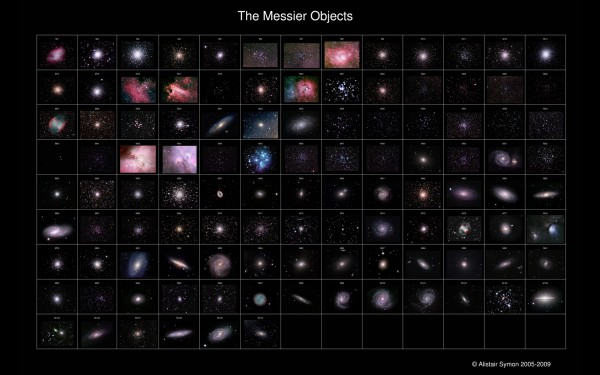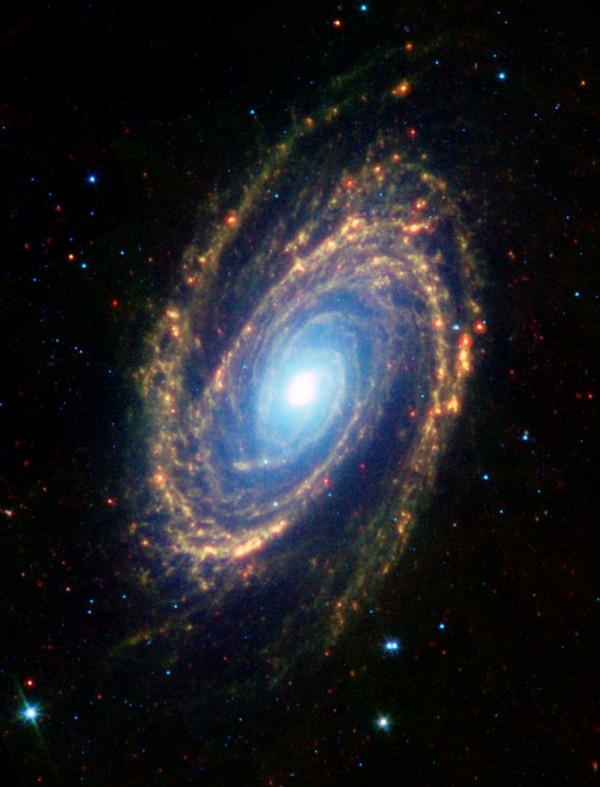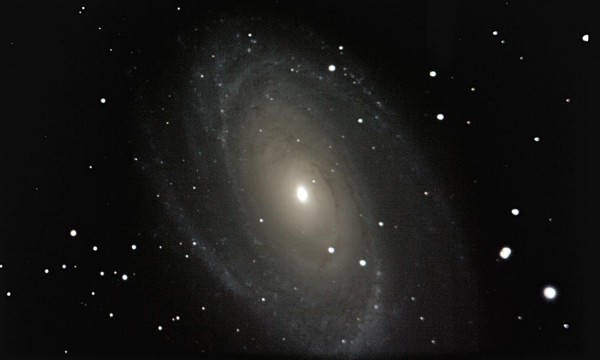"When you look at the stars and the galaxy, you feel that you are not just from any particular piece of land, but from the solar system." -Kalpana Chawla
Welcome to this week's Messier Monday, where I pick a new object out of the original catalogue of 110 "faint fuzzies" designed to help comet-hunters avoid confusion with these fixed, extended night sky objects.
In previous weeks, we've focused on a variety of objects, including a globular cluster, an open star cluster, a supernova remnant and an active star-forming nebula. Yet the largest, grandest and most spectacular of Messier objects has not yet been represented in our series so far: the galaxies.
This week, I'd like to introduce you to a very special galaxy, Bode's Galaxy (or Messier 81), which has the distinction of being the very first galaxy outside of the Milky Way I ever found for myself. Here's how to do it.

Image credit: Me, using the free software Stellarium, available at http://stellarium.org/.
Although the December Solstice is fast approaching, meaning that the Big Dipper is at its worst for visibility in the early parts of the night, the Northern Hemisphere still gets good views of at least the "cup" of the dipper during nearly all parts of the night.
And if you can find the "cup" of the Big Dipper, you can find where Bode's Galaxy (or Bode's Nebula) is. Draw an imaginary diagonal line from the inside bottom star (Phecda) towards the outermost tip of the cup (Dubhe), and then move again the same distance in almost exactly the same direction.

Image credit: Me, using the free software Stellarium, available at http://stellarium.org/.
Under ideal conditions (ideal human eyes, ideal darkness), it's the farthest object visible to the naked human eye. Through even a small telescope or decent binoculars, you won't be able to miss what appears to be a bright, stationary cloud in the night sky. (The smaller, cigar-shaped one is a Messier object for a different Monday!)
But through even a reasonably large amateur telescope with rather simplistic software, the detail inherent in the galaxy is exquisite. As far as galaxies go, this is one of the most interesting, close-by ones in the entire sky! (Rob Knop and I have a history with it, too.)
Yes, it's big and bright: at just 12 million light years away, it dominates its own galaxy group: the M81 group, and has a brilliant core, some large extended spiral arms, with that pink evidence of star formation written all over it.
But there's so much more. First off, the reason its arms are so wispy, extended and pink is because Messier 81 is an interacting galaxy: gravitationally disrupted by its neighbors and characterized by cosmic violence. This Hubble Space Telescope image captures this exquisitely.
Because of how powerful Hubble is, the full-size image (>300 MB; watch out!) contains remarkable detail in each tiny component of the image above. A tiny sample is available below.
But this galaxy hasn't just been imaged in the visible portion of the electromagnetic spectrum. At shorter, more energetic wavelengths, the Ultraviolet light (shown in blue) characterizes regions of current star formation, while the X-rays (shown in purple) reveal that the core of this galaxy is in fact active, as its central, supermassive black hole feasts on the surrounding material!
Its central black hole is maybe 20 times as massive as the one the Milky Way has, weighing it at 70 million times the mass of our Sun. It's also the most distant large galaxy to actually be blueshifted, or moving towards us. This will not continue, mind you, as the entire M81 group is still receding from our local group. As the takeover of Dark Energy continues, the entire M81 group will eventually disappear from our sky, although it may be the final galaxy group to do so in our Universe.
We can also find some amazing things if we look at longer wavelengths, or at this galaxy in infrared light.
The red colors, above, indicate heated dust in the interstellar medium, where stars may form in the future, and the green hues are evidence of polycyclic aromatic hydrocarbons, which may be the original organic building blocks for the life we know on Earth.
No matter how you look at Messier 81, it's guaranteed to give you an impressive window into just one galaxy out of the hundreds of billions in our Universe.
Stars are forming, the central black hole is active, a merger is forthcoming and somewhere, 12 million light years away, the primordial ingredients for life are coming together. Someone from that galaxy looking at Earth would be able to find the first apes, but nothing that had even begun to resemble a human being.
When we look out at these Messier objects, we are always looking backwards in time. But the galaxies -- the most distant of the Messier objects -- provide the greatest window back into the Universe of all. If you've never seen one, grab a pair of binoculars and look for them some night: you'll never forget seeing a galaxy with your own eyes for the first time!
So, including today's entry, we've covered five of the 110 Messier objects so far:
- M1, The Crab Nebula: October 22, 2012
- M8, The Lagoon Nebula: November 5, 2012
- M15, An Ancient Globular Cluster: November 12, 2012
- M45, The Pleiades: October 29, 2012
- M81, Bode's Galaxy: November 19, 2012
Which one will be next? Join me each Monday for a new one, and suggest your ideas below! (I have been known to listen, sometimes.) We'll have a new Messier object -- and a new window into the night sky -- waiting for you to discover!










Don't forget that in 1993, a supernova occurred in M81. Because M81 is so close to the Milky Way, anyone with a small telescope could see the supernova (SN 1993J) with his own eyes when it was near its peak brightness. It was one of only two supernovae I've managed to detect directly visually; the other was SN 2011fe, which was roughly one magnitude fainter and so much more difficult to detect.
Hey! Come on! They're a pair! M81/M82.
Sheesh, this is like having a discussion about Stan Laurel and missing out Olliver Hardy..!
Nice! :) Will try to find it with my celestron 60.
As for ideas for next messier object. How about m31? :) Be nice to our neighbors ;)
Ethan needs to take a photo of M31 himself before he covers than one, IMHO.
SL,
The messier catalogue is (apart from light extinction for items near the horizon) easily visible in a scope around 60mm in aperture.
Some, like the globular cluster in Orion, are not resolved well enough to display their unique characteristics, mind, but all can be seen.
The problem with m31 is that it really isn't worth looking at by eye. Too big for a large scope to fit in the field of view, too dim in the arms to be seen in anything smaller, leaving the smudge in the middle.
It's a lovely photographic object, mind.
Even with a camera and a 100mm lens (tracked for at least 30 seconds) should show up a lot more and, more intriguingly, the satellite galaxies of M31.
If your scope has a whitworth mount for the camera, consider piggybacking the camera on the scope and taking a photo for 1 minute of the area and use the eyepiece to track by hand. Then you can
a) use it to star-hop to the right location again
b) look at the image to see what you can look at next time to see (e.g. M101 next to M31)
@Wow
thanx for advice. Appreciate it.
I strongly disagree on M31 not being worth looking at with the eye, especially in a big scope -- as long as it's the right kind.
M31 is too large for a big SLOW scope like my 11" F/10, where my widest FOV is 0.5 degrees. For reference, Andromeda is about 3 x 1 degrees.
But in a fast scope with a wide-angle eyepiece it looks amazing. It looks great in a 10" F/4.5, or, oh my god, in a 20" F/4. Throw a 31mm Nagler in it and mmmmmmmmmm....
If your "Celestron 60" is the PowerSeeker refractor that google coughed up then it's an F/12 which is less than ideal for such a big object. But with a 20mm Plossl you can get a 1.4 degree field which will easily encompass the galaxy's width and a little less than half its length.
60mm is not enough to get any good detail, but give it a shot and you may end up enjoying it anyway!
Maximum ActualFOV for a 2" eyepiece is the focal length of the telescope in mm divided by 2800.
20" F4.5 has a focal length of 2286mm. Actual FOV at best is 1.2 degrees.
Object is 3x1 degrees.
A 31mm Nagler with a FOV of 82degrees still can't get any more actual sky than a little less than 1 degree (31*82/2800).
2286/2800 is 0.82, not that any of those numbers are relevant.
Actual FOV is (eyepiece FOV / magnification), or (eyepiece FOV * eyepiece FL / telescope FL).. A 20" F/4 with a 31mm nagler has an AFOV of (82* 31 / 2000) = 1.27 degrees.
Which is enough to comfortably encompass the width of Andromeda, and allow easy perusal of the breadth with a little panning.
And it's an awesome, awesome feast for the eyes. Nobody who sees it says otherwise.
I mean if your calculation was correct, the 20" f4 wouldn't be able to achieve a wider field than my C11 f10 (2800mm FL) with the same eyepiece, which is demonstrable nonsense.
Other way up, CB, which is why you're going wrong.
2800/2286.
And also why your follow up was wrong.
2800/2800 greater than 2800/2286.
It's simple geometry. As most optics is.
Heck, just take the idea of what a longer focal length would do to the actual FOV of the same eyepiece.
Longer focal length: higher magnification: smaller AFOV.
AFOV is inversely proportional to Telescope FL.
Merely logical thought. No maths required.
(and it should have been "less than" above).
You are, however correct that the 82 degree Nagler would be bigger than 1 degree. 1.11.
You're the one who said max FOV was "focal length of the telescope in mm divided by 2800" and then said that was 1.2. So yes you went wrong. :)
Then you said that that a 2286mm FL telescope would have an FOV with the 31 nagler of (31*82/2800), implying no dependence on telescope FL, which is utterly wrong and silly and contrary to logical thought indeed. So glad we agree on that.
Instead it's exactly like I've been saying/calculating all along: AFOV = eyepiece FOV * eyepiece FL / telescope FL.
For the 20" f4 that I've been talking about, with the 31mm nagler that would be what I said originally: 1.27 degrees.
For a hypothetical 20" f4.5 (you must have misread my first post), yes, you FINALLY have it correct that it would be 82 * 31 / 2286 = 1.11 degree.
For my C11 f10, the number 2800 finally becomes relevant, as that would be 82 * 31 / 2800 = 0.91, not that I own one.
So, to summarize, the 20" f4 telescope I was talking about would have a 1.27 degree FOV, just like I said, which is sufficient to enjoy a wonderful view of Andromeda.
"a 2″ eyepiece is the focal length of the telescope in mm divided by 2800."
Yup, got it the wrong way round. DId the calculation correctly, though for the 20".
Point is you get barely a degree from your 20".
You can spot the dust lanes on a 12"+ but you'd be looking at a PART of the Andromeda Galaxy.
It's a far better photographic object. You can't get enough light in from a wide enough cone to see the andromeda the same way with the eye.
Pleiades and Coma Bernices (that one needs a 7x bino or less too) are the same.
The dumbell nebula gets better as you get a bigger scope, likewise globula clusters.
But a few of the Messier objects are really just a wonderment not because of what you see there but because of what it is that you're seeing: another galaxy, 2 million light years away. The image itself is pretty underwhelming by eye.
Something that the glossy astronomy books are, IMO, doing a disservice by. You're going to be disappointed if you look at those glossy photo images and then look at M31. Mostly you're thinking "It looks a LOT smaller".
M52 is harder to see but more interesting because its arms are more visible compared to the core.
I'm glad to see I'm not the only one that M81 holds a special meaning to! I actually have a tattoo of M81. I based it off of a NASA/ESA composite image that was a bit more aesthetic for tattooing purposes.
-Chelsea
thequantumview.blogspot.com
I finally captured M81 for the first time using my Canon T5i and a fixed tripod stacking technique (very short exposure times for each sub). Sigh. Fuzzy gray blobs, but I still like knowing that I can catch the light.
M81 (Bode's Galaxy) and M82 (Cigar Galaxy) with DSLR on Fixed Tripod
But it isn't just Messier 81 that is showing blueshift in the M81 Group. Apparently 5 other galaxies, all dwarf galaxies, are approaching us. Not to mention some galaxies in the IC 342/Maffei Group are also blueshifted. (ie: Maffei 2, NGC 1569)
But yeah, they won't always be blueshifted. Because of the expansion of the universe and dark energy, even little starburst galaxy will recede from us. Better to look at M81 now before it is too late.